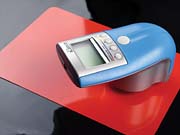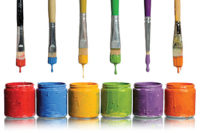
Author: Judith Pietschmann/Research Institute for Precious Metals and Metal Chemistry
Publisher: Vincentz Network, 2004, Hannover, Germany
Pages: 116
Order information: books@coatings.de or www.coatings.de
If we lived in a perfect world we wouldn't need a book such as this one by Judith Pietschmann. Unfortunately not everything occurs as planned. Hence, the need for a guide to assist in determining the cause and effect of powder coating defects. This book provides a "concise, practical and robust" examination of a myriad of problems that can occur in the use of organic powder coatings. Replete with excellent photography, Pietschmann provides a broad compendium of surface defects encountered in powder coating. The book is a translation of the German text, which was published prior to this English version.
This is Dipl. Ing. Pietschmann's second book. Her perspective is through analytical eyes as opposed to a formulator or powder applicator. She is part of the Research Institute for Precious Metals and Chemistry (FEM) in Germany. Ms. Pietschmann currently heads the group for Aluminum Surface Technology. She has done extensive work on the mechanisms and causes of filiform corrosion. Most recently she has concentrated on the analysis of powder coating defects.
The book is neatly divided into numerous sections concerning various types of defects encountered in the application, curing and exposure of powder coating finishes. After a cursory introduction and discussion on the general causes of defects, the book presents separate sections on most of the defects that can occur in powder coatings. The format consists of a description of the defect, causes, prevention and recommendations on how to repair the finish. Each section includes color photographs usually made under optically magnified conditions.
The strength of this book lies mainly with the excellent photography. It is at its best with the cross-sectional views. Some of the straight on visualizations lose the definition of a surface phenomenon such as gloss or texture variation.
The pictorial exposition of blisters is extremely useful. They show not only the defect but also the source of the flaw. The series of photos clearly illustrate the porosity in the substrate responsible for the blister and also the cavity generated in the coating from the expulsion of gases from the pores.
The perspective presented is mainly through the eyes of an analytical physicist. Causes associated with powder formulation are given only cursory examination. Additionally, remedies through powder choice or reformulation are given short shrift. For example, she states that coarsely textured powder finishes are most prone to exhibiting defects. I think that most powder formulators would say a high-gloss black is more difficult to achieve contamination free.
The English-speaking reader will notice that some of the descriptions don't translate well from German. For example, the terminology "false pretreatment" can be assumed, but the word usage is rather awkward.
Overall this guide is very useful and should be on every powder finisher's and formulator's bookshelf. It can be an invaluable resource for identifying powder film defects and implementing the necessary remedies.
Editors Note: As someone who has worked in defect analysis for most of my career, I can honestly say that this book is an invaluable resource for defect analysis. The micrographs and photos are some of the best I have seen.


Report Abusive Comment